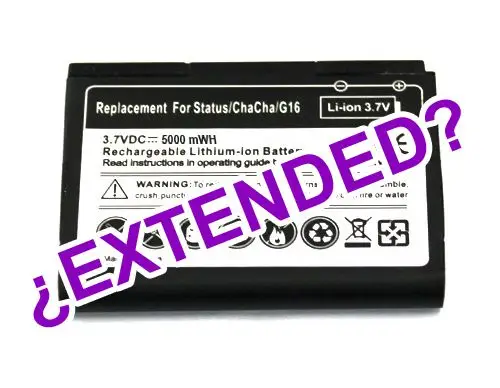It’s been days since I posted, because I’ve been busy with many issues and I haven’t had time to write anything. But today I’ve been to Mediamarkt (a store that, in case you didn’t know, is expensive) and I’ve seen something that should almost be considered false advertising, and it’s also hard to detect. I’ll give you the specific case I’ve seen with the battery of a Samsung Galaxy S2 although this, obviously, also happens in other phones and in other stores. At the end of the article I include a brief mathematical explanation for those interested.
A Samsung Galaxy S2 comes with a standard 1650 mAh battery. In addition to original batteries, and one with a capacity of 1800 mAh, batteries of 3300, 5000 and 6100 mWh were also sold. WATCH OUT, here’s the catch! mWH. Logically, it seems to be a much larger battery, and in fact it was more expensive than the original replacement. But, how do we convert mWh to mAh? Dividing by the battery voltage, that is, 3.7V. Thus, the capacities of these “extended batteries” actually result in 890, 1350 and 1650 mAh, respectively. The “scam” is that the 6100 mWh battery cost 10 euros more than the original, even though they have the same capacity. So be careful, pay attention to the units, and not just the price.
As advice, I recommend that you only use original batteries in your mobile phones. Lithium ion batteries are complex, and a cheap manufacturing process usually means lower charges and a shorter lifespan. And of course, be wary of “miracle” batteries. Lithium ion technology has a charging limit in relation to its volume, and factory batteries are around this maximum, so it is very unlikely that a “Chinese” battery will have a higher charging capacity.
Now for those who are up for a dense explanation, a bit of mathematical talk.
The energy stored in a battery should be measured, according to the SI, in Joules (J). Since Energy = Power x Time, the Watt hour (Wh) is admitted as an alternative unit of energy, which is the amount of energy equivalent to a power of Watt (W) for a time of one hour, that is, 1 Wh = 3600 J. However, historically, batteries have been measured in mAh (milliampere hour), and this is due to the relationship Power = Current x Voltage. Given a constant nominal voltage in a battery, its charge capacity can be expressed as the product of electrical current, measured in Amperes (A), by time. It can be deduced that the capacity of a battery in mWh can be obtained from its capacity in mAh multiplied by its nominal voltage. Thus, an alkaline battery of 1.5V and 2000 mAh stores an energy of 3000 mWh and a hypothetical lithium ion battery of 3.7V and 2000 mAh would store an energy of 7400 mWh.
